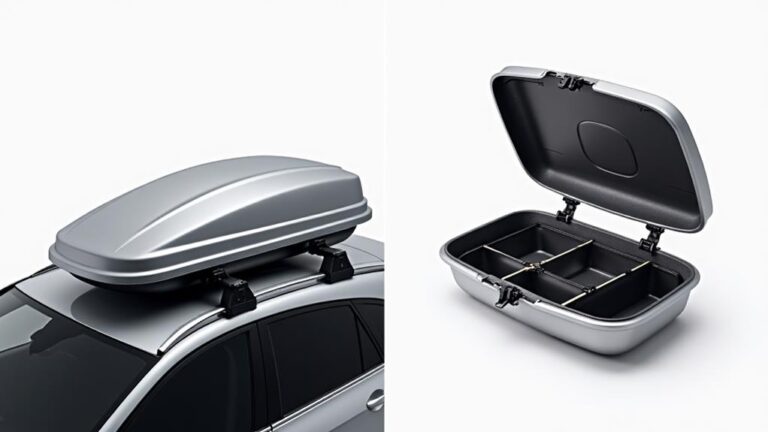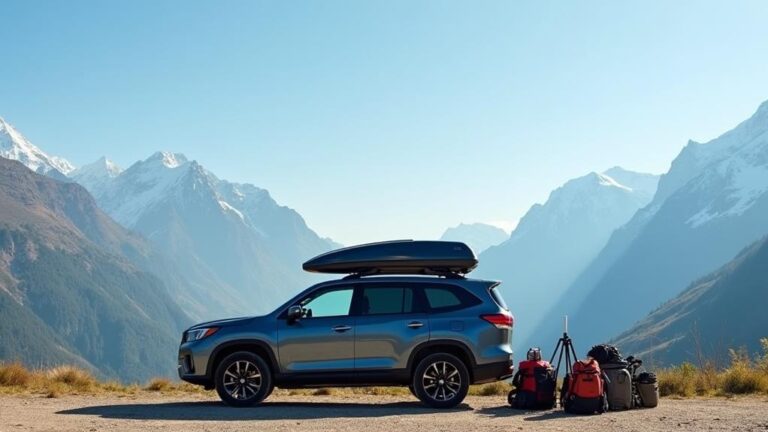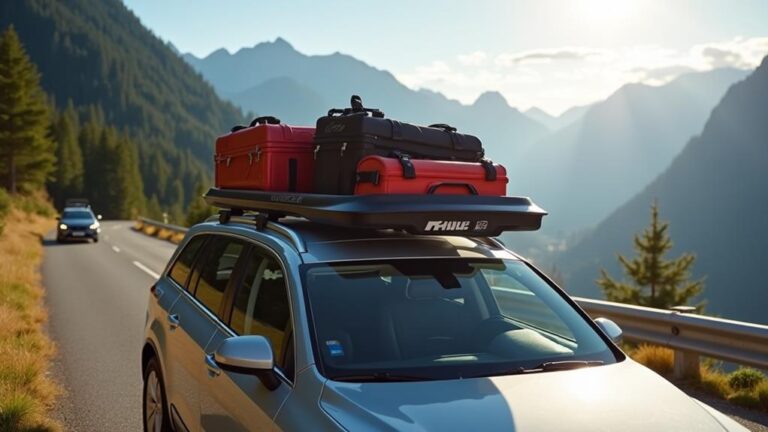A roof top tent can be the anchor that holds your adventures together, but before you set sail, it's essential to consider the weight that will be holding you down. As you explore the world of roof top tents, you'll find that their weights vary significantly, influenced by factors such as type, size, and material. You might be surprised to know that even the smallest tents can weigh over 70 pounds, and the largest ones can tip the scales at over 250 pounds. But what exactly contributes to these weights, and how will it affect your vehicle's roof capacity?
Key Takeaways
- The average weight of a soft-shell roof top tent ranges from 70-120 pounds (32-54 kg), accommodating 2-4 people.
- Hard-shell roof top tents typically weigh between 80-180 pounds (36-82 kg) for 2-4 people, due to their solid frames and waterproof roofs.
- Larger roof top tents, designed for 4-6 people, can weigh anywhere from 150-250 pounds (68-113 kg), depending on materials and features.
- Hybrid roof top tents, offering a balance between hard-shell and soft-shell options, typically weigh between 100-200 pounds (45-91 kg).
- Additional components like ladders, bedding, and roof racks add to the overall weight of a roof top tent, affecting vehicle roof capacity limits.
Average Roof Top Tent Weight
Within the realm of roof top tents, weight is a crucial factor to consider, especially when it comes to vehicle loading and overall camping setup.
When selecting a roof top tent, you'll find various tent types, each with distinct weight ranges. Soft-shell roof top tents typically weigh between 70-120 pounds (32-54 kg), accommodating 2-4 people, while hard-shell options range from 80-180 pounds (36-82 kg) for the same capacity.
Larger tents, designed for 4-6 people, can weigh anywhere from 150-250 pounds (68-113 kg).
Hybrid roof top tents, combining elements of soft-shell and hard-shell designs, usually fall within the 100-200 pounds (45-91 kg) range. These weights apply to the tent itself and don't account for additional components like ladders, bedding, or roof racks, which contribute to the overall weight.
When evaluating roof top tent options, you should consider your vehicle's weight capacity, as well as your personal preference for setup and teardown ease. By weighing these factors, you can choose the right tent for your needs and camping style.
Factors Affecting Tent Weight
When considering the weight of your roof top tent, you'll want to examine the factors that contribute to its overall mass.
The size and shape of the tent, materials and construction methods used, and accessory and feature weights all play a significant role in determining its total weight.
Tent Size and Shape
You're likely considering various factors that impact the weight of your rooftop tent, and tent size and shape are crucial ones.
The size of your rooftop tent directly affects its weight, as larger tents require more materials to construct. A bigger tent means more fabric, poles, and hardware, ultimately leading to increased weight.
When choosing a rooftop tent, you should also consider its shape and profile.
Tent profiles can vary, ranging from low-profile designs to more spacious, high-profile options. Low-profile tents are generally lighter, as they require less material and have a more streamlined design. Aerodynamic shapes can also help reduce weight by minimizing wind resistance, making them ideal for highway driving or high-wind conditions.
Larger, boxier tents, on the other hand, may offer more interior space, but their weight and wind resistance increase accordingly.
Materials and Construction
Most rooftop tents are constructed using a combination of materials, and the specific materials and construction methods used significantly impact the overall weight of the tent.
When evaluating the weight of a rooftop tent, you'll want to consider the type of fabric used for the canopy, walls, and floor.
The fabric density, measured in denier or grams per square meter, is a key factor in determining the weight and durability of the tent. Thicker fabrics with a higher denier rating will generally be heavier, but offer greater resistance to wind, rain, and UV damage.
The frame of the tent is another critical component that affects its weight.
Frame durability is essential for withstanding various weather conditions and ensuring the tent remains stable and secure. You'll often find frames made from aluminum, steel, or fiberglass, with aluminum being a popular choice for its strength-to-weight ratio.
A sturdy frame will typically be heavier, but provides greater peace of mind and a longer lifespan for the tent.
Accessory and Feature Weight
The weight of a rooftop tent is also influenced by the accessories and features it comes with.
When you're evaluating the overall weight of your rooftop tent, consider the accessories that add to its weight. For instance, tent anchors can weigh anywhere from 1-3 pounds each, depending on the type and brand.
If you're planning to use multiple anchors, you'll need to factor their combined weight into your overall calculation.
You'll also want to consider the weight of cargo straps and other tie-downs that secure gear to the roof rack or tent. These straps can add an extra 1-2 pounds to your overall weight, depending on their length and material.
Additionally, some rooftop tents come with built-in features like canopies, awnings, or annexes, which can add significant weight to the overall package.
When calculating the weight of your rooftop tent, it's essential to account for these accessories and features to get an accurate estimate. By factoring in the weight of tent anchors, cargo straps, and other accessories, you can ensure a safe and successful installation of your rooftop tent.
This attention to detail will help you avoid any potential issues with your vehicle's weight capacity.
Hardshell Vs Softshell Tents
When comparing hardshell and softshell roof top tents, you'll notice significant differences in design and weight.
Hardshell tents typically weigh more due to their solid, rigid frames and waterproof hardshell roofs.
In contrast, softshell tents rely on a collapsible design and lighter materials, although their waterproofness may be compromised by their fabric construction.
Hardshell Tent Weight
Hardshell rooftop tents generally weigh between 100 and 200 pounds, significantly heavier than their softshell counterparts. If you're considering a hardshell rooftop tent, it's essential to factor in the weight and how it will affect your vehicle's overall weight capacity and fuel efficiency.
| Hardshell Tent Model | Weight (lbs) | Dimensions (L x W x H) |
|---|---|---|
| iKamper Skycamp | 125 | 84.6 x 48 x 12.6 |
| Roofnest Sparrow | 165 | 84 x 50 x 13 |
| 23 Zero Roof Top Tent | 180 | 88 x 49 x 13.5 |
When choosing a hardshell rooftop tent, consider the trade-offs between weight, tent durability, and shell maintenance. Hardshell tents are generally more durable and easier to maintain than softshell tents, but their weight can be a significant drawback. If you prioritize ease of use and a robust design, a hardshell rooftop tent may be the best choice for you. However, if weight is a concern, you may want to consider a softshell tent or explore options for reducing the weight of your hardshell tent.
Softshell Tent Design
Considering your vehicle's weight capacity and fuel efficiency is vital when choosing between hardshell and softshell rooftop tents.
Softshell tents are a popular choice for many adventurers due to their unique benefits and flexible design. They have a lower weight and a more compact design compared to hardshell tents. This makes them ideal for smaller vehicles or those with limited roof space.
Softshell tents also offer more tent flexibility, allowing you to set them up in tight spaces or on uneven terrain.
Fabric construction: Softshell tents are typically made from waterproof and breathable fabrics, such as nylon or polyester.
Frame design: Softshell tents often use a collapsible frame that provides support and stability when set up.
Attachment system: Softshell tents usually attach to your vehicle's roof rack using straps or clamps.
Setup process: Softshell tents can be more time-consuming to set up compared to hardshell tents.
Weather resistance: Softshell tents are designed to withstand various weather conditions, including rain and wind.
Roof Top Tent Material
The choice of roof top tent material significantly impacts its weight. When selecting a roof top tent, you'll encounter various materials that cater to different needs and preferences.
Fabric is the most common material used for roof top tents, and its weight varies depending on the type and quality.
You'll typically find fabrics with polyester or nylon construction, which offer a balance of durability and water resistance. The fabric's weight is usually measured in denier (D), with higher ratings indicating increased durability and water resistance. A 150D fabric, for example, is lighter and more suitable for casual camping, while a 300D fabric is heavier and more suitable for frequent or extreme use.
Other materials, such as aluminum or fiberglass, are used for the tent's frame and poles. These materials contribute significantly to the overall weight of the roof top tent.
Additionally, some roof top tents feature hardshell or fiberglass construction, which can add substantial weight due to the increased material density.
When evaluating roof top tent materials, consider factors like fabric durability, water resistance, and the weight of the frame and poles to determine the best option for your needs.
Size and Occupancy Limits
When choosing a roof top tent, you'll want to think about the number of people it can accommodate and how much space you need.
Tent dimensions and occupancy ratings are crucial factors to consider, as they directly impact the weight and overall usability of the tent.
Tent dimensions vary widely, but most roof top tents fall into a few standard size categories.
Occupancy ratings, on the other hand, are based on the number of people the tent can comfortably sleep.
- *Tent floor area*: Measured in square feet or meters, this is the usable space inside the tent.
- *Peak height*: The maximum interior height of the tent, which affects standing room and comfort.
- *Occupancy ratings*: Typically range from 1-4 people, depending on the size and design of the tent.
- *Sleeping capacity*: Some tents may have a higher sleeping capacity than occupancy rating, depending on the layout and design.
- *Interior layout*: Consider the layout of the tent, including features like windows, doors, and storage compartments, when evaluating its overall usability and comfort.
Additional Features and Weight
A roof top tent's overall weight is significantly influenced by its additional features and materials. When you're shopping for a roof top tent, you'll notice various tent customization options that can impact the weight. Some of these features include annexes, canopies, and storage solutions. Luxury features like built-in mattresses, LED lights, and USB ports can also add to the overall weight.
Here's a comparison of some common additional features and their estimated weights:
| Feature | Estimated Weight | Impact on Overall Weight |
|---|---|---|
| Annex | 10-20 lbs (4.5-9 kg) | 5-10% increase |
| Canopy | 5-10 lbs (2.3-4.5 kg) | 3-5% increase |
| Built-in Mattress | 10-20 lbs (4.5-9 kg) | 5-10% increase |
When considering these features, you'll want to weigh the benefits against the added weight. Keep in mind that some features, like built-in mattresses, may be essential for comfort, while others, like canopies, may be more of a luxury. By understanding the weight implications of these features, you can make informed decisions when choosing a roof top tent that meets your needs and preferences.
Vehicle Roof Capacity Limits
Most vehicles have a maximum roof capacity limit that must be taken into account when installing a roof top tent. This limit is usually specified by the vehicle manufacturer and can be found in the owner's manual or on a placard located on the driver's side doorjamb.
It's crucial to consider this limit to ensure safe and proper installation of the roof top tent.
When calculating the load capacity of your vehicle's roof, you should consider the following factors:
- Dynamic load: The weight of the tent and occupants when the vehicle is in motion
- Static load: The weight of the tent and occupants when the vehicle is stationary
- Weight distribution: The even distribution of weight across the roof to prevent uneven stress on the vehicle's structure
- Load calculation: The total weight of the tent, occupants, and any additional gear
- Roof rack weight: The weight of the roof rack itself, which must be factored into the overall load calculation
It's essential to carefully consider these factors to ensure that your vehicle's roof capacity limit isn't exceeded, which can compromise the safety and integrity of the vehicle.
Choosing the Right Tent
Selecting a roof top tent that suits your needs requires careful consideration of several factors, including your vehicle's roof capacity limit, the number of occupants, and the type of camping you plan to do.
When choosing the right tent, you'll need to consider the roof style of your vehicle, as different styles may require specific mounting systems. For example, a hard-shell roof top tent may be ideal for vehicles with a fixed roof rack, while a soft-shell tent may be better suited for vehicles with a track-mounted roof rack.
You'll also need to decide on a tent type that fits your needs. There are three main types: hard-shell, soft-shell, and hybrid.
Hard-shell tents are durable and provide excellent protection from the elements, but they can be heavy and more expensive. Soft-shell tents are lighter and more affordable, but they may not provide the same level of protection. Hybrid tents offer a balance between the two, with a durable hard-shell floor and a soft-shell upper section.
Frequently Asked Questions
Can Roof Top Tents Be Installed by One Person?
You can attempt solo installation, but consider assistance for improved safety and tent stability. Weighing factors include the tent's size, material, and your vehicle's roof type, affecting the complexity of the installation process.
Are Roof Top Tents Suitable for Extreme Weather?
You're likely weighing the benefits of rooftop tents in serene landscapes versus harsh conditions. When it comes to extreme weather, you'll want to consider wind resistance and snow loads, as they significantly impact tent performance and safety.
Can I Add Extra Storage to My Roof Top Tent?
You can enhance your roof top tent's functionality by adding extra storage solutions like cargo organizers or purchasing separate extra compartments specifically designed for your model, allowing you to keep gear organized and easily accessible.
Do Roof Top Tents Require a Ladder for Entry?
You'll find most roof top tents require a ladder for entry, but you have ladder options to improve tent accessibility, such as retractable or slide-out ladders, and some models even offer alternative entry systems.
Are Roof Top Tents Compatible With All Vehicle Types?
Don't worry, you're not limited by your vehicle choice. Roof top tents are compatible with many types, but check vehicle restrictions and weight capacity to ensure a safe fit, usually on SUVs, trucks, and wagons.
Conclusion
Don't let the weight of your dreams hold you back. A rooftop tent's weight is a crucial consideration, but it's not a burden to bear. With options ranging from lightweight soft-shells to sturdy hard-shells, you can find the perfect balance between comfort and portability. Choose wisely, and the weight of your rooftop tent will be a mere whisper in the wind, allowing you to soar to new heights and explore the world with ease.












